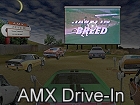Site Tools & Extras
Quick Links
American Motors eXperimental
1970 AMX

1970 was the last year of production as a separate model for the AMX. On the 1971 - 1974 Javelin, 1977 Hornet, 1978 Concord, and 1979 - 1980 Spirit, the AMX would become a performance option.
A number of changes occurred for the 1970 AMX. The exterior updates included a different hood with a Ram-Air scoop, the grille was brought out flush and was now home to the parking lights. The front had grown slightly more than an inch. The front bumper was also changed slightly with vents to cool the front brakes. The brake lights were different and the rocker panel moldings now took on the look of sidepipes. The height of the AMX was reduced by about an inch, while the overall length grew about two inches. The wheelbase remained 97 inches.

The interior changes were numerous; the bucket seats now had integrated headrests and no longer reclined. The dash, console and door panels took on a different look. The steering wheel was the new Rim-blo design (squeeze the rim to blow the horn) and the steering column now held the ignition switch.
The 290 and 343 were replaced by the 360 as the base engine, with the 390 as the only option. All 1970 engines had the race-proven dog-leg exhaust port heads. The 360 put out 280hp @ 4800 rpm. The 390 was now rated at a conservative 325 hp @ 5000 rpm. Both engines came with 10.0:1 compression ratios, down from 10.2:1 in '68 and '69. Borg Warner transmissions were still used, the 360 cars had the M-11, the 390's were backed by the stronger M-12. Four speeds got the T-10.
Most options remained the same as in 1969. Fourteen inch rally wheels were standard, but for 1970 the 15 inch Rebel Machine wheels were offered as a factory option. The Go-Pakage now consisted of the 360 or 390 with standard four-barrel and dual-exhaust; power front disc brakes; Goodyear F-70x14 small raised white letter tires; handling package; Twin Grip differential in various ratios (2.87 or 3.15 with automatics, 3.54 with 4-speeds); heavy-duty cooling; and functional Ram Air hood. Group 19 performance equipment was still available as dealer installed items.

The 1970 AMX was offered in 14 exterior colors, eight new colors along with six carry-over colors. The three Big Bad Colors were still available, although they now came with chrome bumpers. All colors could be ordered with the flat-black Shadow Mask two tone. Rally stripes were a separate option - no longer a part of the Go-Package - and were designed in a C -shape available in black, white, or red and were not available with the Shadow Mask option.
Leather and vinyl seats were available in red, black or saddle. Platinum was replaced with medium blue as a vinyl interior color.
Sales of the $3,395.00 1970 AMX fell to 4,116 units, nearly half of the previous year. Much of the sales decline can be attributed to a less aggressive marketing plan by American Motors.

Here is a listing of some of the options and their costs for the 1970 AMX:
Power Brakes $43.00. Power Steering $102.00. Air Conditioning $380.00. Rear Bumper Guards $13.00. Tinted Glass all windows $34.00. Windshield only $26.00. Shadow Mask Paint Treatment $52.00. Leather Seats $84.00. Eight-Track stereo with manual AM radio and twin rear speakers $195.00. Go-Package with 360 engine $298.85. With 390 engine $383.90. Quick Ratio Manual Steering $16.00. Power Disc Brakes $84.00.
"The story of AMERICAN AUTOMOBILES"

This rendering of the 1970 AMX was done by Mike Micos. It is on the cover of this small (15 page) AMC publication.
Inside the back cover is the following text:
American Motors Corp. plays an important role in the auto industry, which accounts for one-fifth of the U.S. economy.
Right from the beginning, American Motors and its predecessors have been in the vanguard of progress and performance.
In 1901, American Motors cars introduced the first steering wheel. The 1902 Rambler was one of the first mass produced autos in the world, logging a sales record of 1500 its first year.
American Motors cars were also the first with an enclosed rear deck for luggage and with rubber mounted engines.
Giant strides were made in the auto industry through AM-introduced single-unit construction for car bodies, floor to roof rustproofing, reclining seats, adjustable head restraints, seat belts, and molded ceilings to cut noise.
The U.S. car industry was forced into another revolution in 1950 when the Rambler compact was placed on the market to give motorists more economy and value at lower prices.
The American Motors stable now includes a family of cars aimed at the specific needs and wants of any buyer.
There’s the Ambassador for those who want affordable luxury in transportation;
The AMX for the sports car buff;
The Javelin for performance-minded swingers;
The Rebel for those who want intermediate size and comfort at compact car prices; and
The Hornet for the economy minded, or for those who want small car size and price, but the choice of luxury car options.
American Motors, a company dedicated to progress and everything that it takes to build and design automobiles that are right for today.






